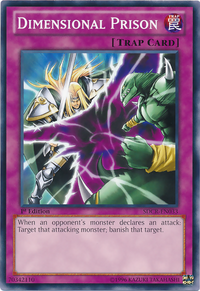| Banish
| |||
|---|---|---|---|
| Japanese |
ゲームから | ||
| Japanese (ruby) |
ゲームからじょがいする (formerly ゲームからとりのぞく) | ||
| Japanese (base text) |
ゲームから除外する (formerly ゲームから取り除く) | ||
| Japanese (romanized) |
Gēmu kara Jogaisuru (formerly Gēmu kara Torinozoku) | ||
| Japanese (translated) |
Remove from the game | ||
| English |
Banish (formerly Remove from play) | ||
| |||
Banish, formerly known as remove from play prior to the Problem-Solving Card Text update and called excluded from the game (Japanese: ゲームから
Cards can only be banished by a card that uses the word "banish" (or "remove from play" for cards without Problem-Solving Card Text).
Banished cards cannot be destroyed. Returning a banished card to the Graveyard does not count as sending that card to the Graveyard. Unless banished face-down, banished cards are public knowledge.
The Banished Zone can be placed anywhere on the table, as it has no actual place in the game since it is not actually a zone (as demonstrated from its absence on official play mats). However, it is typically placed either above or to the right of the Graveyard Zone, or just under the field (right in front of the player). Most video games place it to the right of the Graveyard.
Banishing face-down
By default, cards are banished face-up, and banished cards are public knowledge. However, several cards can banish cards face-down, such as "Goblin Circus", "Ghostrick Skeleton" and "Xyz Override"; a card that is banished face-down cannot be looked at by either player, and cannot be used for any purpose except that prescribed on the card that banished it.
History
Originally, there were not many cards which could banish other cards ("remove from play" at the time, which originally was the case), with some of the first being "Soul Release" and "Banisher of the Light". The first card to return them was "Miracle Dig".
However, over time, banishing has become a popular theme with several cards to go with it (Chaos and "D.D." cards). In turn, more cards were created to bring them back, including "D.D.M. - Different Dimension Master", "Dimension Fusion", "Dimension Explosion", "Burial from a Different Dimension", and "Leviair the Sea Dragon".
In the Problem-Solving Card Text update, "remove from play" was renamed "banish" to make card texts less "clunky" and easier to understand, because in normal English "remove" and "from play" would often be broken up making many card texts unclear. Also, the term was often confused with "removed from the field", which was renamed "leaves the field" for this reason.[1]
Thematically, cards which banish tend to either imply that the card's soul is being removed (e.g. "Kycoo the Ghost Destroyer", "Bazoo the Soul Eater") or are sent to another dimension (e.g. the "D.D." series).
Deck theme
Since many Decks rely on the Graveyard, Decks that rely on the effects of "Dimensional Fissure", "Macro Cosmos", "Banisher of the Light", and "Banisher of the Radiance", along with have grown in power. Being able to shut down an opponents Graveyard plus having "D.D. Survivor", an 1800 ATK monster that keeps returning every time it's banished while face-up, have shown themselves to be powerful Decks. "D.D. Scout Plane" is also incredibly useful in these Decks: if it is banished from your hand or Deck, it will be Special Summoned. The main weakness of these Decks is the fact that it is not difficult to remove the card that banishes other cards; "Imperial Iron Wall" counters such Decks with ease.
Structure Deck: The Dark Emperor revolves around banishing.
References
- ↑ Tewart, Kevin (May 23, 2011). "Problem-Solving Card Text, Part 2: New Words & Phrases". Konami. https://yugiohblog.konami.com/articles/?p=2915. Retrieved July 28, 2011.

